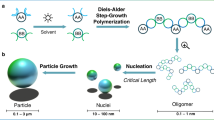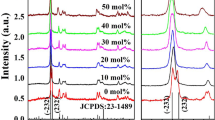Abstract
The spray drying method was used to prepare luminescent microspheres. These microspheres were prepared by spraying an aqueous solution of dextrin and an europium(III) complex with subsequent drying in a hot medium. The spray dried powder was characterized by scanning electron microscopy (SEM) and photoluminescence spectroscopy (PL). Particle size distribution was estimated from SEM images. The ultrasonic spray drying technique was successfully applied to yield a microparticulated and red luminescent powder composed by the [Eu(dpa)3]3− (dpa = dipicolinic acid) complex incorporated in dextrin microspheres.






Similar content being viewed by others
References
Loksuwan J (2007) Characteristics of microencapsulated b-carotene formed by spray drying with modified tapioca starch, native tapioca starch and maltodextrin. Food Hydrocoll 21(5–6):928–935
Braga GK, Oliveira WP (2007) Manufacturing drug loaded chitosan microspheres by spray drying: development, characterization, and potential use in dentistry. Dry Technol 25(2):303–310
Ré MI (1998) Microencapsulation by spray drying. Dry Technol 16(6):1195–1236
Mujumdar AS (1995) Handbook of industrial drying. Marcel Dekker, New York
www.buchi.com, accessed on May 2007
Freitas S, Merkle HP, Gander B (2004) Ultrasonic atomisation into reduced pressure atmosphere-envisaging aseptic spray-drying for microencapsulation. J Control Release 95(2):185–195
Asaji K (1979) Microcapsule processing and technology. Marcel Dekker, New York
Giunchedi P, Conte U (1995) Spray-drying as a preparation method of microparticulate drug delivery systems: an overview. S.T.P. Pharma Sci 5(4):276–290
Okuyama K, Lenggoro IW (2003) Preparation of nanoparticles via spray route. Chem Eng Sci 58(3–6):537–547
Avvaru B, Patil MN, Gogate PR, Pandit AB (2006) Ultrasonic atomization: effect of liquid phase properties. Ultrasonics 44(2):146–158
Suh WH, Suslick KS (2005) Magnetic and porous nanospheres from ultrasonic spray pyrolysis. J Am Chem Soc 127(34):12007–12010
Abdullah M, Iskandar F, Shibamoto S, Ogi T, Okuyama K (2004) Preparation of oxide particles with ordered macropores by colloidal templating and spray pyrolysis. Acta Mater 52(17):5151–5156
Ré MI (2006) Formulating drug delivery systems by spray drying. Dry Technol 24(4):433–446
Xie Y-L, Zhou H-M, Zhang Z-R (2007) Effect of relative humidity on retention and stability of vitamin A microencapsulated by spray drying. J Food Biochem 31(1):68–80
Desai KGH, Park HJ (2005) Encapsulation of vitamin C in tripolyphosphate cross-linked chitosan microspheres by spray drying. J Microencapsul 22(2):179–192
Chiou D, Langrish TAG (2007) Development and characterisation of novel nutraceuticals with spray drying technology. J Food Eng 82(1):84–91
Desai KG (2007) Properties of tableted high-amylose corn starch–pectin blend microparticles intended for controlled delivery of diclofenac sodium. J Biomater Appl 21(3):217–233
Santa-Cruz PA, Teles FS. Spectra Lux Software v.2.0, Ponto Quântico 2003, Nanodispositivos/RENAMI.
Moynihan S, Lacopino D, O'Carroll D, Doyle H, Tanner DA, Redmond G (2007) Emission colour tuning in semiconducting polymer nanotubes by energy transfer to organo-lanthanide dopants. Adv Mater 19(18):2474–2479
Panigrahi BS (2002) A fluorimetric study of terbium, europium and dysprosium in aqueous solution using pyridine carboxylic acids as ligands. J Alloys Compd 334(1–2):228–231
Porcher P (1999) In: Saez R, Caro PA (eds) Rare earths. Editorial Complutense, Madrid
Lehn JM (1990) Perspectives in supramolecular chemistry—from molecular recognition towards molecular information processing and self-organization. Angew Chem Int Ed 29(11):1304–1319
Zhao B, Chen X-Y, Cheng P, Liao D-Z, Yan S-P, Jiang Z-H (2004) Coordination polymers containing 1D channels as selective luminescent probes. J Am Chem Soc 126(47):15394–15395
Cicillini SA, Calefi PC, Neri CR, Nassar EJ, Serra OA (1999) Use of polymeric resin in the formation of SiO2 hybrid gels. J Non-Cryst Solids 247(1–3):114–119
DeOliveira E, Neri CR, Serra OA, Prado AGS (2007) Antenna effect in highly luminescent Eu3+ anchored in hexagonal mesoporous silica. Chem Mater 19(22):5437–5442
George MR, Golden CA, Grossel MC, Curry RJ (2006) Modified dipicolinic acid ligands for sensitization of europium(III) luminescence. Inorg Chem 45(4):1739–1744
Puntus LN, Zolin VF, Babushkina TA, Kutuza IB (2004) Luminescence properties of isomeric and tautomeric lanthanide pyridinedicarboxylates. J Alloy Compd 380(1–2):310–314
Binnemans K (2005) Handbook on the physics and chemistry of rare earths. Elsevier, Amsterdam
Fernandes A, Jaud J, Dexpert-Ghys J, Brouca-Cabarrecq C (2001) Study of new lanthanide complexes of 2,6-pyridinedicarboxylate: synthesis, crystal structure of Ln(Hdipic)(dipic) with Ln = Eu, Gd, Tb, Dy, Ho, Er, Yb, luminescence properties of Eu(Hdipic)(dipic). Polyhedron 20(18):2385–2391
Luz PP, Pires AM, Serra OA (2007) A low-cost ultrasonic spray dryer to produce spherical microparticles from polymeric matrices. Quim Nova 30(7):1744–1746
ImageJ 1.38 bundled with Java 1.6.0_02.
Gmelin L (1980) Gmelin Handbuch der Anorganischen Chemie—Sc, Y, La–Lu rare earth elements (Part D1—coordination compounds). Springer, Berlin
Blasse G, Grambmaier BC (1994) Luminescent materials. Springer, Berlin
de Mello Donegá C, Alves Júnior S, de Sá GF (1997) Synthesis, luminescence and quantum yields of Eu(III) mixed complexes with 4,4,4-trifluoro-1-phenyl-1,3-butanedione and 1,10-phenanthroline-N-oxide. J Alloys Compd 250(1–2):422–426
Kodaira CA, Brito HF, Malta OL, Serra OA (2001) Luminescence and energy transfer of the europium (III) tungstate obtained via the Pechini method. J Lumin 101(1–2):11–21
Acknowledgements
The authors gratefully thank Dr R. F. Silva for helpful discussions and FAPESP for financial support and scholarships.
Author information
Authors and Affiliations
Corresponding author
Rights and permissions
About this article
Cite this article
Luz, P.P., Pires, A.M. & Serra, O.A. Europium Luminescent Polymeric Microspheres Fabricated by Spray Drying Process. J Fluoresc 18, 695–700 (2008). https://doi.org/10.1007/s10895-008-0343-0
Received:
Accepted:
Published:
Issue Date:
DOI: https://doi.org/10.1007/s10895-008-0343-0




